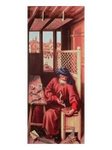In my search for vintage tools, such as spoon bits for a hand brace, I've turned to Ebay and have dived into the modern electronic world of online bidding. Sometimes, I've awed by things like a cast-iron kettle that sold for US$265. I've discovered the practice of 'sniping' or lurking without bidding until the very end. The point is to deny any competing bidders the chance to out bid you (technically, a chance to raise their maximum bid above yours). For some, the very end is the last five minutes or so. For others, it's the last ten seconds. I've watched tools I was interested in sit for five to seven days without a single bid, and then end in a flurry of a dozen bids in the last hour. I'm starting to recognize familiar usernames. I've also found it necessary to search under various terms and categories, since one person's collectible shell bit is another person's rusty odd tool (perhaps a chisel?).
So far, I've managed to pick up two shoemaker's hammers, one US and one French made. A modern spoon bit in 5/8", and a lot assortment of small spoon bits and gimlets. There was a lovely rosewood hand brace that eluded me, but I found some online selling for three times the bids. I should make my own brace. Wood and brass I can handle. Tool steel is a little harder to deal with.
Thursday, February 15, 2007
Monday, February 12, 2007
Woodwrights
I just like working wood. Problem is, I don't have much of a shop, mostly a corner in a storage unit that requires moving stuff out of the way when I want to work. And if the weather is bad, I'm not inclined to do that. While I like the modern powertools, I have a fondness for 'old-fashioned' woodworking. Roy Underhill and his 'Woodwright's Shop' PBS series, books series, and website are among my favourites, even if more 19th century than medieval. Although much of the tools and techniques still remained at that time. I'm rather impressed with Roy's expressed intention for a person to be able to walk into the forest with an axe, and to then build their tools and their shop with which to make those other things they want to make. Admittedly, he often uses tools that are neither an axe nor made of wood, but that's the general mindset. I understand that when they created Colonial Williamsburg, they used modern tools to make historic tools. Then they made the next generation of tools with those historically designed, but modernly made tools. And now they are on the third generation of tools, made by tools made in the historical method.
Ultimately, my goal is to be able to go to a historical recreation or an SCA event with wood and period or near period (i.e. 19th tools of a compatible style) tools and make something useful by the end of the event (an folding X chair, a stool, a table, etc). And I'm not inclined to pack in an entire wood shop, either. Just some basic journeyman tools and a minimal woodbench. But then, the Roman and medieval woodbench was basically that: a wooden bench on which the woodwright sat upon both the work and the bench. And those legs are just in tapered holes, so they fit tight and still can be pulled out.
Ultimately, my goal is to be able to go to a historical recreation or an SCA event with wood and period or near period (i.e. 19th tools of a compatible style) tools and make something useful by the end of the event (an folding X chair, a stool, a table, etc). And I'm not inclined to pack in an entire wood shop, either. Just some basic journeyman tools and a minimal woodbench. But then, the Roman and medieval woodbench was basically that: a wooden bench on which the woodwright sat upon both the work and the bench. And those legs are just in tapered holes, so they fit tight and still can be pulled out.
Subscribe to:
Posts (Atom)
